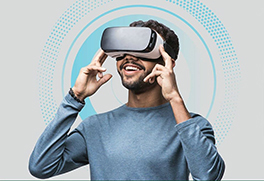New from the Faculty of Engineering: The Neuroengineering Track

During his post-doctoral studies at MIT, Dr. Shahar Alon met artist Neil Harbisson, the first person recognized by the British government as a human cyborg. Born completely colorblind, Harbisson had an antenna implanted in his skull, translating colors into sound. The antenna sends vibrations to his head, creating different notes for each color. It’s also connected to a chip for internet access, allowing him to sense colors from space via satellite, as well as receive emails, texts and phone calls directly into his head. “Harbisson demonstrates the future of humanity,” says Dr. Shahar Alon, head of the new neuroengineering track at Bar Ilan’s Faculty of Engineering. “Technology is headed towards optimal interfacing with the brain, receiving information in the best possible manner, and upgrading it. It could completely change the world of video games – say, playing a car racing game while wearing a helmet that detects whether you want to turn left or right – but also significantly improve the lives of people with various disabilities such as communication or neurological disorders. Clearly, the potential is enormous, and our goal is to improve the brain/machine interface and prepare for a future of greater convergence between humans and computers, even without drilling into our skulls”.
Per Dr. Alon, the new track was something the public desired: “We have plenty of students who sign up for electrical engineering, but are also interested in neuroscience, particularly BMI (Brain/Machine Interface), which lets us use engineering to connect to the brain and receive or transmit information. It’s an advanced, highly sought-after field. Many companies are joining the trend, including Google, Facebook, and Elon Musk’s Neurolink. It’s popular in academia, too: neruoscientific research is yearning for new technologies that would enable measuring brain activity on a large scale, diagnose and treat neurological disorders such as Alzheimer’s, achieve a true understanding of the brain, and answer burning questions such as wherein the brain each activity takes place”.
One great example of the potential of BMI is mind reading. Today’s technology can detect basic thoughts (yes, no, left, right), but if we were to ask a neuroscientist if mind-reading is possible, their answer would be a definite no; we’re still not clear on the definition of ‘thought’. In the physical realm, things happen on a cellular level, but when it comes to thinking – we have no idea which cells change, and how. In other words, we still don’t know how thoughts manifest in the physical realm. The scientific world is yearning for new technologies that can measure and manufacture big data from the brain, and to people who can analyze this information and deduce from it.
The new track relies on the infrastructure of the electrical engineering program, and in fact, the first two years in both tracks are identical (which means that students who have already started the electrical engineering track can join). The neuroengineering focus starts in the third year, with eight specially designed courses, including neuron network modeling, neurotechnology, nervous system diseases – diagnostic and treatment technologies, brain imaging, and neurogenomics. Students will also be required to take courses in neuroscience, including neurophysiology, neuroanatomy, and a neurobiology lab at The Leslie and Susan Gonda (Goldschmied) Multidisciplinary Brain Research Center. The track is headed by Dr. Alon, a physicist with a PhD in neuroscience from Tel Aviv University and over five years of experience at the MIT neuroengineering lab – one of the most prestigious labs in the world. The track is co-head by Prof. Orit Shefi, head of the neuroengineering lab at Bar Ilan, as well as the following senior faculty members: Prof. Rachela Popovtzer, Prof. Aryeh Weiss, Dr. Amos Danieli, Dr. Tomer Kalisky, Prof. Gur Yaari, Prof. Yaakov Goldberger and Prof. Sharon Ganot of the Faculty of Engineering, Prof. Yossi Mandel of the Faculty of Life Science, head of the neuroscience center Prof. Alon Korngreen, Prof. Hamutal Slovin, Prof. Michal Ben-Shachar, Prof. Izhar Bar-Gad, Prof. Zeev (Ed) Stern, Dr. Dana Cohen, and Dr. Ilana Zion-Golumbic of the neuroscience center.
Is the new track for you? “The answer is yes,” says Alon, “if you’re a creative quantitative thinker with excellent learning skills – which are already the requirements for electrical engineering – but also with interest, curiosity and an honest desire to explore the human brain, discover how it works and how we can exploit its potential. This is the first track of its kind in Israel, and one of the firsts in the world. Students who want to hear more about the new track, ask questions, and find out if they’re a good fit can learn more on our page or contact me directly at shahar.alon@biu.ac.il.” ".
Last Updated Date : 07/07/2020



